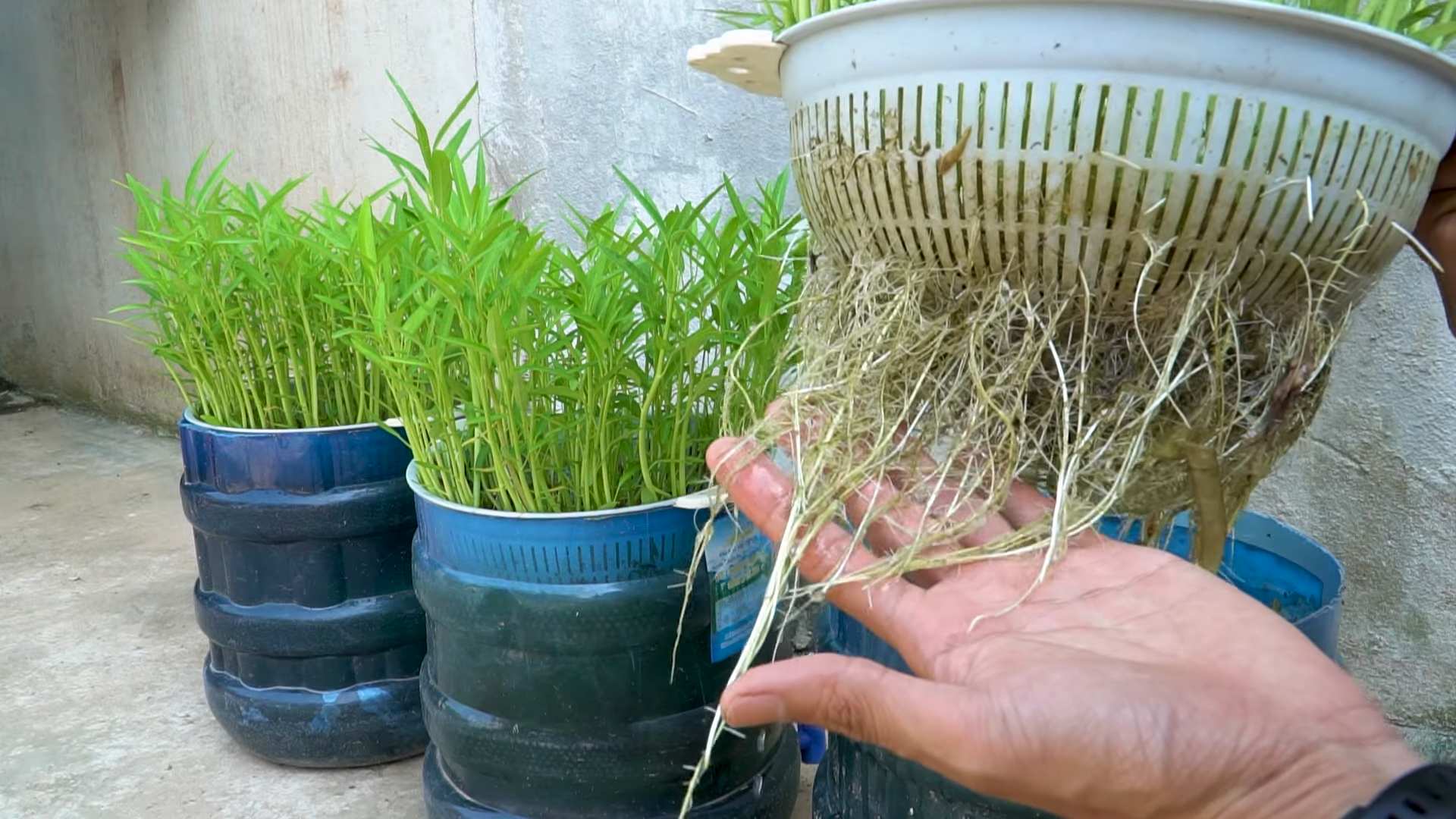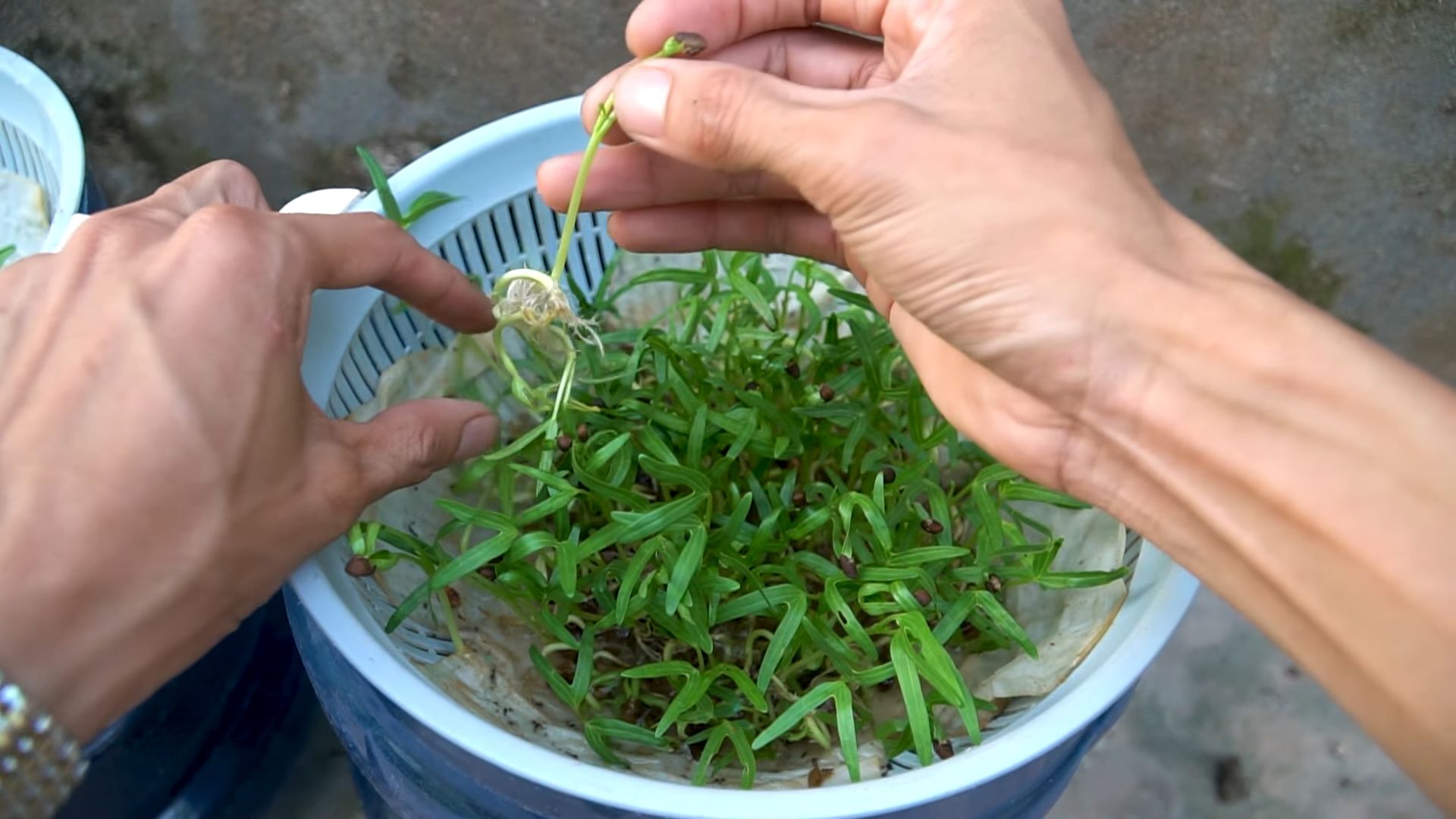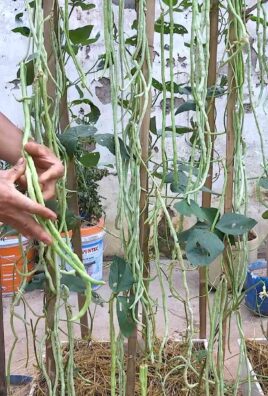Hydroponic Water Spinach DIY: Ready to ditch the grocery store greens and grow your own delicious, nutrient-packed water spinach right at home? I’m so excited to share this incredibly simple and rewarding DIY project with you! For centuries, water spinach, also known as Ong Choy, has been a staple in Asian cuisine, prized for its crisp texture and mild, slightly sweet flavor. But did you know you don’t need a sprawling garden to enjoy this leafy green?
This isn’t just about saving money; it’s about connecting with your food, understanding where it comes from, and enjoying the freshest possible ingredients. Imagine stepping outside your door and harvesting vibrant, healthy water spinach for your stir-fries, salads, or soups. With this hydroponic water spinach DIY guide, I’ll walk you through each step, from setting up your simple system to harvesting your first crop.
In today’s world, where access to fresh, affordable produce can be a challenge, learning to grow your own food is more important than ever. Plus, hydroponics is a fantastic way to garden in small spaces, making it perfect for apartment dwellers or anyone with limited outdoor space. So, let’s dive in and discover the joy of growing your own hydroponic water spinach!

DIY Hydroponic Water Spinach: A Beginner’s Guide
Hey there, fellow plant enthusiasts! Ever wanted to grow your own fresh, crunchy water spinach (also known as kangkong or ong choy) right in your kitchen? Well, you’re in the right place! I’m going to walk you through a super simple DIY hydroponic setup that’s perfect for beginners. Trust me, if I can do it, you can too! We’ll be using the Kratky method, which is a passive hydroponic system – meaning no pumps or electricity needed after the initial setup. Let’s get started!
What You’ll Need
Before we dive in, let’s gather our supplies. Don’t worry, most of these are easily found at your local hardware store or online.
* Container: A dark-colored, opaque plastic container with a lid. Think a storage tote, a bucket, or even a repurposed container. The size depends on how much water spinach you want to grow, but something around 5-10 gallons is a good starting point. The darkness is crucial to prevent algae growth.
* Net Pots: These are small, slotted pots that will hold your water spinach seedlings. You’ll need enough to accommodate the number of plants you want to grow. 2-3 inch net pots are ideal.
* Growing Medium: This will support your seedlings in the net pots. I recommend using coco coir, rockwool cubes, or clay pebbles (LECA). They’re all inert and provide good drainage and aeration.
* Hydroponic Nutrients: This is the food for your plants! You’ll need a balanced hydroponic nutrient solution specifically formulated for leafy greens. Look for something with a higher nitrogen content.
* Water Spinach Seeds: Of course! You can find these at most garden centers or online. Make sure they’re fresh for the best germination rate.
* Drill or Hole Saw: To create holes in the lid of your container for the net pots.
* Measuring Cups and Spoons: For mixing your nutrient solution.
* pH Meter (Optional but Recommended): To monitor the pH of your nutrient solution. Water spinach prefers a pH between 6.0 and 7.0.
* pH Up and pH Down (Optional): To adjust the pH of your nutrient solution if needed.
* Seed Starting Tray or Small Pots: For germinating your seeds.
* Grow Light (Optional): If you don’t have a sunny spot, a grow light will help your water spinach thrive.
* Marker: For marking the water level on your container.
Germinating Your Water Spinach Seeds
This is the first step to growing your own hydroponic water spinach. Germination is the process of the seed sprouting and developing into a seedling.
1. Soaking the Seeds: Place your water spinach seeds in a small bowl and cover them with lukewarm water. Let them soak for 12-24 hours. This helps soften the seed coat and encourages germination.
2. Preparing the Seed Starting Tray: Fill your seed starting tray or small pots with a seed starting mix or coco coir. Moisten the medium thoroughly.
3. Sowing the Seeds: Sow the seeds about 1/4 inch deep in the moistened medium. Gently cover them with more medium.
4. Providing Moisture and Warmth: Cover the seed starting tray with a clear plastic lid or plastic wrap to create a humid environment. Place the tray in a warm location (around 70-80°F or 21-27°C). You can use a heat mat to provide bottom heat if needed.
5. Monitoring and Watering: Check the tray daily and mist the medium with water to keep it moist but not soggy. Avoid overwatering, as this can lead to fungal diseases.
6. Waiting for Germination: Water spinach seeds typically germinate within 3-7 days. Once the seedlings emerge, remove the plastic lid or wrap to allow for better air circulation.
7. Providing Light: Place the seedlings under a grow light or in a sunny window. Ensure they receive at least 6-8 hours of light per day.
Setting Up Your Hydroponic System
Now for the fun part! We’re going to assemble our hydroponic system.
1. Preparing the Container: Clean your plastic container thoroughly with soap and water. Rinse it well to remove any soap residue.
2. Drilling the Holes: Place the lid on the container. Using a net pot as a template, mark the locations for the holes on the lid. Make sure to space them evenly to allow for adequate plant growth. Use a drill or hole saw to cut the holes. The holes should be slightly smaller than the diameter of the net pots so they fit snugly.
3. Adding the Nutrient Solution: Fill the container with water, leaving about 2-3 inches of space at the top. This is important to allow for air space between the water and the bottom of the net pots.
4. Mixing the Nutrients: Add your hydroponic nutrient solution to the water according to the manufacturer’s instructions. Use measuring cups and spoons to ensure accurate measurements.
5. Checking the pH (Optional but Recommended): Use your pH meter to check the pH of the nutrient solution. Adjust the pH to between 6.0 and 7.0 using pH up or pH down solutions if necessary.
6. Marking the Water Level: Use a marker to mark the initial water level on the side of the container. This will help you monitor the water level and add more nutrient solution as needed.
Transplanting Your Seedlings
Once your seedlings have developed a few sets of true leaves (the leaves that look like miniature versions of the adult leaves), they’re ready to be transplanted into your hydroponic system.
1. Preparing the Net Pots: Fill the net pots with your chosen growing medium (coco coir, rockwool cubes, or clay pebbles). Moisten the medium slightly.
2. Gently Removing the Seedlings: Carefully remove the seedlings from the seed starting tray or small pots. Be gentle to avoid damaging the roots.
3. Placing the Seedlings in the Net Pots: Place the seedlings in the net pots, ensuring that the roots are surrounded by the growing medium.
4. Placing the Net Pots in the Container: Place the net pots into the holes in the lid of the container. The bottom of the net pots should be just touching the nutrient solution. This will allow the roots to access the water and nutrients.
Caring for Your Hydroponic Water Spinach
Now that your water spinach is in its new home, it’s time to provide the care it needs to thrive.
1. Providing Light: Water spinach needs plenty of light to grow well. If you have a sunny spot, place your hydroponic system there. If not, use a grow light to provide at least 6-8 hours of light per day.
2. Monitoring the Water Level: Check the water level regularly and add more nutrient solution as needed to maintain the initial water level.
3. Checking the pH (Optional but Recommended): Check the pH of the nutrient solution every few days and adjust it as needed to maintain a pH between 6.0 and 7.0.
4. Changing the Nutrient Solution: Change the nutrient solution every 2-3 weeks to prevent the buildup of salts and maintain optimal nutrient levels.
5. Providing Air Circulation: Ensure that there is good air circulation around your water spinach plants. This will help prevent fungal diseases. You can use a small fan to provide air circulation if needed.
6. Pest Control: Keep an eye out for pests such as aphids or spider mites. If you find any pests, treat them with an organic insecticide or insecticidal soap.
Harvesting Your Water Spinach
The best part! You can start harvesting your water spinach about 3-4 weeks after transplanting.
1. Harvesting the Stems: Use scissors or a knife to cut the stems of the water spinach about 2-3 inches above the water level.
2. Encouraging Regrowth: Leave the bottom portion of the stems intact to encourage regrowth. Your water spinach will continue to produce new stems for several weeks.
3. Enjoying Your Harvest: Wash your harvested water spinach thoroughly and enjoy it in salads, stir-fries, soups, or any other dish you like.
Troubleshooting
Even with the best care, you might encounter some problems along the way. Here are a few common issues and how to address them:
* Yellowing Leaves: This could be a sign of nutrient deficiency. Make sure you’re using a balanced hydroponic nutrient solution and that the pH is within the optimal range.
* Slow Growth: This could be due to insufficient light. Make sure your water spinach is getting enough light, either from a sunny window or a grow light.
* Algae Growth: This is usually caused by too much light

Conclusion
So, there you have it! A simple, effective, and incredibly rewarding method for growing your own hydroponic water spinach. This DIY approach isn’t just about saving money; it’s about connecting with your food source, understanding the growing process, and enjoying the unparalleled freshness of homegrown vegetables. Forget those limp, pre-packaged greens from the supermarket. With this method, you’ll have crisp, vibrant water spinach at your fingertips, ready to elevate your stir-fries, soups, and salads.
Why is this DIY trick a must-try? Because it democratizes access to fresh, healthy produce. You don’t need a sprawling garden or expensive equipment to enjoy the benefits of hydroponics. This method is scalable, adaptable, and perfect for urban dwellers, apartment residents, or anyone looking to add a touch of green to their lives. Plus, the satisfaction of harvesting your own food is simply unmatched.
But the beauty of this DIY project lies in its flexibility. Feel free to experiment with different nutrient solutions to find what works best for your local water conditions and desired growth rate. Consider adding an air pump and air stone to further oxygenate the water, potentially boosting growth even more. You could also explore different container sizes and materials to optimize space and resource utilization. For example, larger containers might require less frequent water changes.
Don’t be afraid to get creative with your setup! Try using recycled plastic bottles or repurposed containers to reduce waste and give your hydroponic garden a unique, personalized touch. You can even experiment with different lighting options, from natural sunlight to supplemental grow lights, depending on your indoor environment. Remember to monitor your water spinach closely and adjust your approach as needed.
The key to success with this hydroponic water spinach DIY project is observation and adaptation. Pay attention to the color and texture of the leaves, the clarity of the water, and the overall health of the plants. If you notice any signs of nutrient deficiency or pest infestation, address them promptly. With a little care and attention, you’ll be rewarded with a bountiful harvest of delicious, nutritious water spinach.
We wholeheartedly encourage you to give this DIY trick a try. It’s a fun, educational, and ultimately rewarding experience that will transform the way you think about food. And most importantly, we want to hear about your journey! Share your experiences, tips, and photos with us in the comments below. Let’s build a community of hydroponic enthusiasts and inspire others to grow their own food. What are you waiting for? Get started today and enjoy the taste of homegrown goodness!
Frequently Asked Questions (FAQ)
What exactly is hydroponics, and why is it beneficial for growing water spinach?
Hydroponics is a method of growing plants without soil, using mineral nutrient solutions in water. It’s beneficial for water spinach because it allows for faster growth, higher yields, and more efficient use of resources like water and nutrients. Since water spinach thrives in water-rich environments, hydroponics provides the ideal conditions for its development. You also have more control over the growing environment, minimizing the risk of soilborne diseases and pests.
What kind of nutrient solution should I use for my hydroponic water spinach?
A balanced hydroponic nutrient solution specifically formulated for leafy greens is ideal. Look for solutions that contain essential macronutrients like nitrogen, phosphorus, and potassium, as well as micronutrients like iron, manganese, and zinc. You can find these solutions at most garden centers or online retailers. Follow the manufacturer’s instructions carefully when mixing the solution, and monitor the pH level regularly to ensure it’s within the optimal range (typically between 6.0 and 6.5).
How often should I change the nutrient solution in my hydroponic system?
The frequency of nutrient solution changes depends on several factors, including the size of your container, the number of plants, and the growth rate of the water spinach. As a general rule, you should change the solution every 1-2 weeks. However, if you notice the water becoming cloudy or the plants showing signs of nutrient deficiency, you may need to change it more frequently. Regularly monitoring the pH and nutrient levels will help you determine the optimal schedule.
What kind of lighting is required for hydroponic water spinach?
Water spinach needs plenty of light to thrive. If you’re growing it indoors, you’ll need to provide supplemental lighting. Fluorescent grow lights or LED grow lights are both good options. Aim for at least 12-14 hours of light per day. If you’re growing it outdoors, choose a location that receives at least 6 hours of direct sunlight per day. However, be mindful of excessive heat, especially during the hottest part of the day.
How long does it take to harvest hydroponic water spinach?
Hydroponic water spinach typically grows much faster than soil-grown water spinach. You can usually start harvesting within 3-4 weeks of planting the seeds or cuttings. Harvest the outer leaves first, allowing the inner leaves to continue growing. This will ensure a continuous supply of fresh water spinach.
Can I use tap water for my hydroponic system?
While tap water can be used, it’s important to let it sit for 24 hours to allow chlorine to dissipate. Ideally, using filtered or reverse osmosis water is best, as it removes impurities that can interfere with nutrient uptake. Always check the pH of your water before adding nutrients.
What are some common problems I might encounter when growing hydroponic water spinach, and how can I fix them?
Some common problems include nutrient deficiencies, algae growth, and pest infestations. Nutrient deficiencies can be addressed by adjusting the nutrient solution. Algae growth can be minimized by keeping the container clean and opaque. Pest infestations can be treated with organic pesticides or by manually removing the pests. Regularly inspecting your plants will help you catch problems early and prevent them from becoming severe.
Is it possible to grow hydroponic water spinach from cuttings instead of seeds?
Yes, growing from cuttings is a very effective method for water spinach. Simply take cuttings from a mature plant, making sure each cutting has at least a few nodes. Place the cuttings in water until roots develop, then transfer them to your hydroponic system. This method allows you to bypass the germination stage and get a head start on your harvest.
How do I prevent algae growth in my hydroponic system?
Algae thrives in light and nutrient-rich environments, so minimizing light exposure to the nutrient solution is key. Use opaque containers to block light, and consider covering any exposed surfaces with aluminum foil or black plastic. Regularly clean the container to remove any algae that does grow. Adding beneficial bacteria to the nutrient solution can also help suppress algae growth.
What are the best ways to use my harvested hydroponic water spinach?
Water spinach is incredibly versatile and can be used in a variety of dishes. It’s commonly used in stir-fries, soups, and salads. It can also be steamed, boiled, or sautéed. Its mild, slightly sweet flavor pairs well with garlic, ginger, soy sauce, and chili peppers. Experiment with different recipes and find your favorite ways to enjoy this delicious and nutritious vegetable.





Leave a Comment